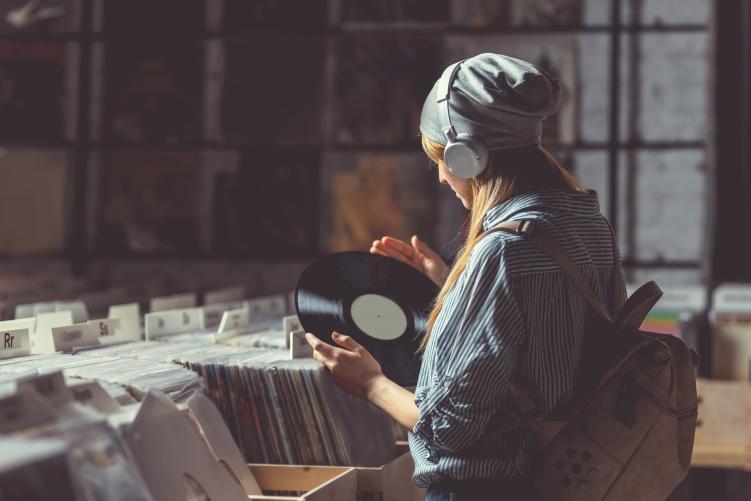Record collecting isn’t everyone’s thing. Some say the process of hunting down vinyl is more than just a hobby; it’s an experience. Others opt for digital music and the latest trend in streaming. But for those who certainly love vinyl – there can be no substitute – it’s a way of life.
Why Collect Vinyl Records?
The real question is: ‘Why not?’ The high-quality sound of vinyl records, the artwork on album covers and inserts, the way your collection looks (and even smells) — all part of the experience. Many people swear they’ll never move past physical music formats; there is something about having a tangible copy of an artist’s work that’s inimitable by digital files alone.
The vinyl industry has long been one that has brought joy to music lovers, big and small. If you’re thinking of starting with your first vintage record but are unfamiliar with what to look for when buying a collectible vinyl record – here’s some advice.
What to Look For?
So, you’ve decided that vinyl records are the way you want to go for your music needs that will play well, along with a great list of affordable turntables. Now, what do you look for when browsing through stacks of classic albums?
Here are some tips that might help you find the best vinyl records for your collection:
- The Condition Of The Vinyl Record
Vinyl records come in three different conditions, based on their flaws: Mint, Very Good Plus (VG+), and Very Good (VG).
- Mint condition: This is considered perfect. It’s hard to find because it’s the grade that most professional sellers will try to sell their records beneath. The vinyl should be clean and free from any marks or scratches, and it should play like new (unless marked as a previously played copy).
You’ll usually find this grade of record at larger music stores, in general, if they deal in higher-end collectible records.
- VG+: This is the upcoming best condition you can hope to find. It’s a little less expensive and is considered more desirable than the lower grade of vinyl records – VG (which we’ll get to next).
When looking at the record, be sure there are no crucial scratches or imperfections on either side. The overall sound should be clean and clear of any distortion. There may also be a noticeable amount of surface noise, but this shouldn’t be too distracting.
- VG: This is the lowest grade a vinyl record can have and still be playable. The skips, pops, and cracks will likely be more frequent and more noticeable than a VG+. These imperfections won’t ruin your album experience altogether, but it’s something you should keep in mind when shopping for your records.
To fully enjoy music on vinyl, you’ll want to get records that are in the best condition possible. Of course, this is going to cost you a bit more. There’s no way around it if you want to enjoy complete albums and avoid having to replace your vinyl collection every few years due to too much wear and tear.
The condition of the album cover is just as essential as that of the vinyl record itself. If you’re really into collecting vintage albums, it’s good to invest in a high-quality cover that will hold up over time. Vinyl can get damaged very well if incorrectly handled, so it’s best to buy a Long Play (LP) that will last.
Here are some great ways to find good album covers:
- Look for glossy, thick paper stock. If the cover feels thin and cheap, you could invest in a replacement.
- The spine of the record should be free from excessive creasing or any other signs of wear.
- The corners of the album cover shouldn’t be dented or look like they’re about to split.
- If the cover feels “bouncy” and you can feel any air pockets underneath it, then it’s probably an inferior quality that won’t last over time. Pass on those and keep looking for a better one.
The inner sleeve is another factor that contributes to the condition of your record. If an album doesn’t come with an inner sleeve, you typically have two options: buy a replacement or skip the purchase altogether.
Replacement inner sleeves are pretty easy to find for most records, and they usually cost somewhere around USD$5. If you’re looking for a record that’s only missing the inner sleeve, then your best bet is to look for an album with a generic plain white paper inner sleeve.
Inner sleeves usually include information about the album and artist, so they help contribute more background on why you should listen to this particular record. When deciding between a few records missing this part, go to the one with a more compulsive or informative cover.
Now you’ve got an idea about the condition of your record and its cover. Now let’s take a look at what’s on the label side. It’s another major factor because the vinyl label design can tell you a lot about its history and how it got to your local music store.
- The label’s design: You want to look for records that have logos with graphics on them, especially if they’re original designs from the artist or record company. For example, most albums from the 70s had bright, colorful album covers with plenty of images and information about the band. Labels like these are typically more durable and tend not to peel off as fast as others.
- The vinyl color: For those who want a record that’s going to stand out from the rest, look for black vinyl records with fully intact labels because they’re harder to find. Colored pieces of vinyl aren’t as popular, but they can still sell well and add a bit of “character” to your home record collection.
Examine the quality of the overall album, including any inserts or other extras. If you can identify extra features on your record, it’s likely in good condition and could be worth purchasing.
- The sound clarity: This is hard to figure out without playing the vinyl record for yourself, but it’s worth viewing. Most records sound like they’re full of static, and you can’t make out the lead singer’s voice, but some sound surprisingly explicit — even if they’re 50 years old. It’s especially true for classic rock albums and vinyl signed by their creators.
- The price: If an album has a high price tag, then something is probably fishy. If a seller wants more than $10 for a record that looks worn out and has scratches on the cover, then you’re likely being tricked into spending too much money.
- The extras: Many albums come with extra features like posters or booklets so take a look at those. Even if desolated, you can typically sell those later on eBay and recoup some of your money.
Final Thoughts
In all, record collecting for beginners can be a great hobby to get into if you have the time and money for it. If you’re starting, try purchasing a few lower-priced records online first, so you know what condition to look for in albums.
If you can’t find a record in good condition, don’t force yourself to purchase it because you have a huge budget. Ultimately, remember that collecting vinyl is all about enjoying your records and putting them to good use.


Record collecting isn’t everyone’s thing. Some say the process of hunting down vinyl is more than just a hobby; it’s an experience. Others opt for digital music and the latest trend in streaming. But for those who certainly love vinyl – there can be no substitute – it’s a way of life.
Why Collect Vinyl Records?
The real question is: ‘Why not?’ The high-quality sound of vinyl records, the artwork on album covers and inserts, the way your collection looks (and even smells) — all part of the experience. Many people swear they’ll never move past physical music formats; there is something about having a tangible copy of an artist’s work that’s inimitable by digital files alone.
The vinyl industry has long been one that has brought joy to music lovers, big and small. If you’re thinking of starting with your first vintage record but are unfamiliar with what to look for when buying a collectible vinyl record – here’s some advice.
What to Look For?
So, you’ve decided that vinyl records are the way you want to go for your music needs that will play well, along with a great list of affordable turntables. Now, what do you look for when browsing through stacks of classic albums?
Here are some tips that might help you find the best vinyl records for your collection:
Vinyl records come in three different conditions, based on their flaws: Mint, Very Good Plus (VG+), and Very Good (VG).
You’ll usually find this grade of record at larger music stores, in general, if they deal in higher-end collectible records.
When looking at the record, be sure there are no crucial scratches or imperfections on either side. The overall sound should be clean and clear of any distortion. There may also be a noticeable amount of surface noise, but this shouldn’t be too distracting.
To fully enjoy music on vinyl, you’ll want to get records that are in the best condition possible. Of course, this is going to cost you a bit more. There’s no way around it if you want to enjoy complete albums and avoid having to replace your vinyl collection every few years due to too much wear and tear.
The condition of the album cover is just as essential as that of the vinyl record itself. If you’re really into collecting vintage albums, it’s good to invest in a high-quality cover that will hold up over time. Vinyl can get damaged very well if incorrectly handled, so it’s best to buy a Long Play (LP) that will last.
Here are some great ways to find good album covers:
The inner sleeve is another factor that contributes to the condition of your record. If an album doesn’t come with an inner sleeve, you typically have two options: buy a replacement or skip the purchase altogether.
Replacement inner sleeves are pretty easy to find for most records, and they usually cost somewhere around USD$5. If you’re looking for a record that’s only missing the inner sleeve, then your best bet is to look for an album with a generic plain white paper inner sleeve.
Inner sleeves usually include information about the album and artist, so they help contribute more background on why you should listen to this particular record. When deciding between a few records missing this part, go to the one with a more compulsive or informative cover.
Now you’ve got an idea about the condition of your record and its cover. Now let’s take a look at what’s on the label side. It’s another major factor because the vinyl label design can tell you a lot about its history and how it got to your local music store.
Examine the quality of the overall album, including any inserts or other extras. If you can identify extra features on your record, it’s likely in good condition and could be worth purchasing.
Final Thoughts
In all, record collecting for beginners can be a great hobby to get into if you have the time and money for it. If you’re starting, try purchasing a few lower-priced records online first, so you know what condition to look for in albums.
If you can’t find a record in good condition, don’t force yourself to purchase it because you have a huge budget. Ultimately, remember that collecting vinyl is all about enjoying your records and putting them to good use.
Related Content: